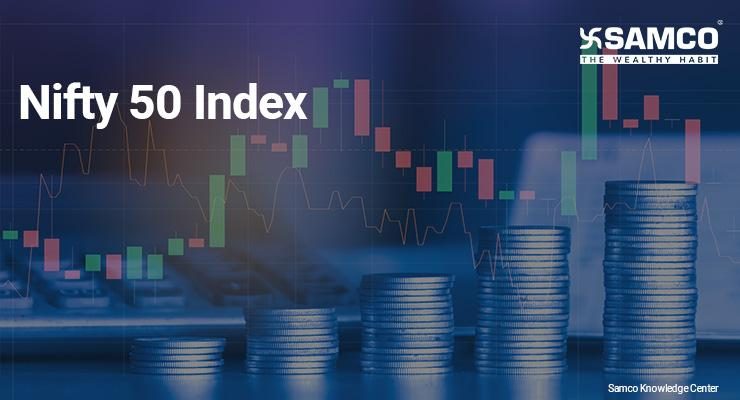If you have been looking for the answer to what the Nifty 50 is, you’re not alone. Most investors starting their journey in the stock market begin by understanding this key index and comparing it to the Sensex.
The Nifty 50 is one of India’s major stock market indices. It is designed to represent the performance of the 50 best companies listed on the NSE (National Stock Exchange). These companies belong to different sectors of the Indian economy. So, together, they give you a clear and comprehensive picture of the market.
The Nifty 50 index is a benchmark for various market participants like investors and analysts. Fund managers also use the Nifty to manage and monitor index-based funds. When the index moves, it gives you an idea of how the top companies on the NSE are performing. This makes it vital for evaluating broad market trends.
In this article, we will discuss the Nifty 50, delve into its significance and meaning beyond its definition, and learn how it is calculated, among other things.
What is the Nifty 50?
The Nifty 50 index is a statistical measure that tracks the performance of some of the best companies listed and traded on the NSE. True to its name, the index consists of the NSE’s fifty largest and most traded stocks. These companies are selected after accounting for factors like their free-float market capitalisation, listing history, and trading value.
They span across 13 different sectors of the economy, including financial services, healthcare, information technology, automobiles and fast-moving consumer goods (FMCG), among others. Since the index covers diverse sectors and includes industry leaders, it realistically reflects the broader market. Here is how the Nifty 50 index represents the overall health of the economy:
A Measure of Business Activity
Knowing the Nifty 50 should help you understand how it mirrors the Indian economy. The Nifty 50 stock list includes major industry participants. When they perform well, it typically indicates positive business sentiment, strong earnings, and growth. If you track their performance, you can get early cues about their movement by studying the index.
A Reflection of Market Sentiment
The index also reflects market sentiment and investor confidence (or lack thereof). Rising values in the Nifty 50 index generally point to growing investor optimism, while sharp declines may indicate a need to exercise caution due to market uncertainty. This makes it a valuable indicator of real-time market and economic health.
A Broader Economic Perspective
Observing and comparing the Nifty 50 vs the Sensex gives you different but often aligned insights into market trends. While both indices track the large companies on one of India’s two major stock exchanges, the Nifty 50 offers broader sectoral coverage and a more diversified view of the economy.
How is the Nifty 50 Calculated?
The Nifty 50 index is computed using the free-float market capitalisation method. This method only considers shares available for trading in the public market. In other words, shares that are locked in, like the promoters’ holdings, are not included in the calculation.
The formula for determining the value of the Nifty 50 index is as follows:
Index Value = (Free-Float Market Capitalisation ÷ Base Market Capitalisation) × Base Index Value
The index's base date is November 3, 1995, and its base value is 1,000. This means the index's movements are measured relative to its total market capitalisation on that specific date. To better understand the Nifty 50 calculation and composition, let's examine the eligibility criteria for Nifty 50 companies and learn how the index is governed.
Eligibility Criteria:
To be a part of the Nifty 50 stock list, a company must meet the strict selection standards in place, which include the following criteria:
- Liquidity: For 90% of its trades over the previous six months, the stock must have a market impact cost of 0.50% or less (for a basket valued at Rs. 100 million).
- Listing History: The company should have been listed and traded on the NSE for at least one month.
- F&O: The stock must be a part of the futures and options segment of the equity markets.
Rebalancing the Nifty 50 Index:
The composition of the Nifty 50 index is reviewed twice a year using market data from the six months leading up to January 31 and July 31 each year. Stakeholders are informed at least four weeks if any changes are to be made. This semi-annual review and rebalancing ensures that the Nifty 50’s calculation and composition remain relevant and aligned with current market dynamics.
Governing the Index:
Like all other indices on the NSE, the Nifty 50 is governed and managed by a three-layer model that includes the Board of Directors of NSE Indices Limited, the Index Maintenance Subcommittee, and the Index Advisory Committee (Equity).
A Closer Look at the Nifty 50 Companies
Now that you have seen the Nifty 50, you should also know that it is a weighted statistical measure. This means that not all the companies in the Nifty 50 stock list influence its movement equally. A few large-cap giants carry significant weight and can sway the index with their price movements.
Check out the top Nifty 50 companies by weight.
Name of the Company | Weight in the Nifty 50 (%) |
13.07 | |
8.95 | |
8.12 | |
5.31 | |
4.37 | |
3.85 | |
3.59 | |
3.46 | |
3.00 | |
2.96 |
The Nifty 50 companies listed above are the key players that often drive the index’s direction of movement. That said, the index is designed to reflect the diversity of the Indian economy. So, it includes companies from various sectors like banking, IT, FMCG and more. The sectoral breakdown of the Nifty 50 index can show you which industries dominate it and how balanced its composition truly is. Check out these details below:
Sector | Weight in the Nifty 50 (%) |
Financial services | 37.30 |
Information technology | 11.91 |
Oil and gas | 9.87 |
Automobile and auto components | 6.93 |
Fast-moving consumer goods | 6.84 |
Telecommunication | 4.37 |
Construction | 3.85 |
Healthcare | 3.80 |
Metals and mining | 3.64 |
Power | 2.83 |
Consumer services | 2.43 |
Construction materials | 2.20 |
Consumer durables | 2.18 |
Capital goods | 1.01 |
Services | 0.82 |
Difference Between the Nifty 50 and the Sensex
So, you know what the Nifty 50 is, but how does it compare with the Sensex? To find the answer, check out this comprehensive Nifty vs Sensex comparison outlining the key differences between the two indices.
Particulars | Nifty 50 | Sensex |
Exchange | National Stock Exchange (NSE) | Bombay Stock Exchange (BSE) |
Number of Stocks | 50 | 30 |
Launched In | 1996 | 1986 |
Base Year | 1995 | 1978–79 |
Base Value | 1,000 | 100 |
Managed By | NSE Indices Limited (a subsidiary of NSE) | S&P BSE Index (a division of BSE) |
Reviewed In | July and January | June and December |
Sectoral Representation | Broader | Narrower |
Why is the Nifty 50 Important for Investors?
As one of the most tracked market indicators in India, the Nifty 50 index plays a critical role in shaping investment decisions. Here are three key reasons why it matters to you as an investor.
A Benchmark for Mutual Funds and ETFs
Many equity mutual funds and ETFs use the Nifty 50 as their benchmarks. This makes it easier to compare the fund’s performance against a standardised market indicator.
Market Trends and Sentiments
The Nifty 50 index reflects the mood of the market. So, its movements can help assess if the investor sentiment is bullish, bearish or uncertain. This makes trade entry and exit easier.
Long-Term Returns and Track Record
Over the years, many Nifty 50 companies have delivered solid long-term growth. By studying their historical performance, you can evaluate potential returns through different market cycles.
Conclusion
To sum it up, the Nifty 50 is a vital indicator of India’s market movements and economic state. By understanding what the Nifty 50 is and how it works, you can read sectoral trends better, assess investor sentiment more easily and get a clearer picture of the overall market health. Ensure that you remain updated about the movements of the Nifty 50 index, so you can align your portfolio with the market trends that it indicates.




 Easy & quick
Easy & quick
Leave A Comment?